Abstract
Ultraviolet light, which is the major etiology of human skin cancer, will cause mutations in the p53 gene. We and others have found that such mutations occur in more than one-half of non-melanoma squamous cell cancer and precancer. Immunostaining for p53 has disclosed a characteristic compact pattern not only in cancer/precancer but also in areas of microscopically normal epidermis termed p53 patches. By microdissection, sequence analysis of the p53 gene, and analysis of loss of heterozygosity (LOH) at the site of this gene, we have now extended previous data to ascertain whether these p53 patches are precursors of simultaneously present squamous cell cancer or its morphologically recognized precancerous stages (dysplasia, carcinoma in situ). In none of 11 instances with co-existence of a p53 patch with dysplasia or in situ or invasive cancer were the mutations identical. We conclude that p53 patches, estimated to be approximately 100,000 times as common as dysplasia, have a very small or even no precancerous potential. Their common presence demonstrates that human epidermis contains a large number of p53 mutations apparently without detrimental effect. The only result of the mutation may be a clandestine benign clonal keratinocyte proliferation. The importance of p53 mutations for such benign cell multiplication on one band and malignant transformation on the other is unclear. Although the spectrum, type, and multiplicity of mutations were similar in both types of proliferative responses, there was a clear difference with respect to LOH. No LOH was found in 17 p53 patches. By contrast 11 of 30 precancers/cancers had LOH.
Full text
PDF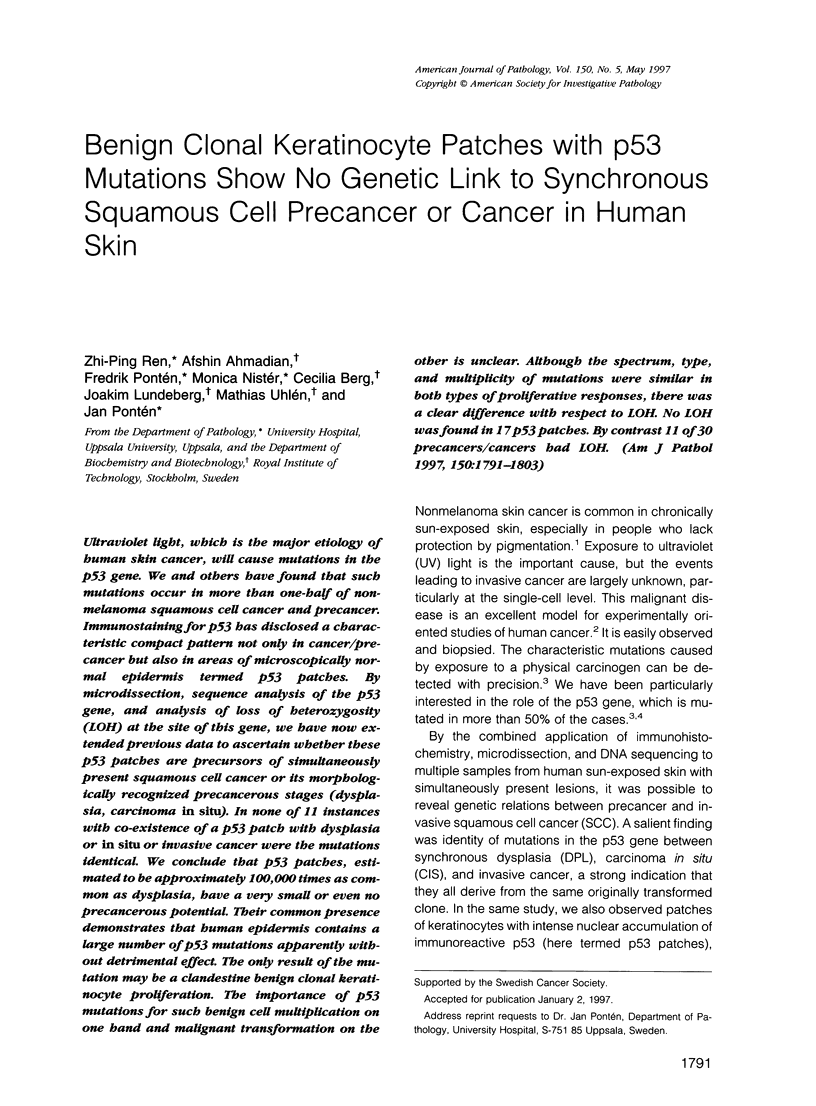
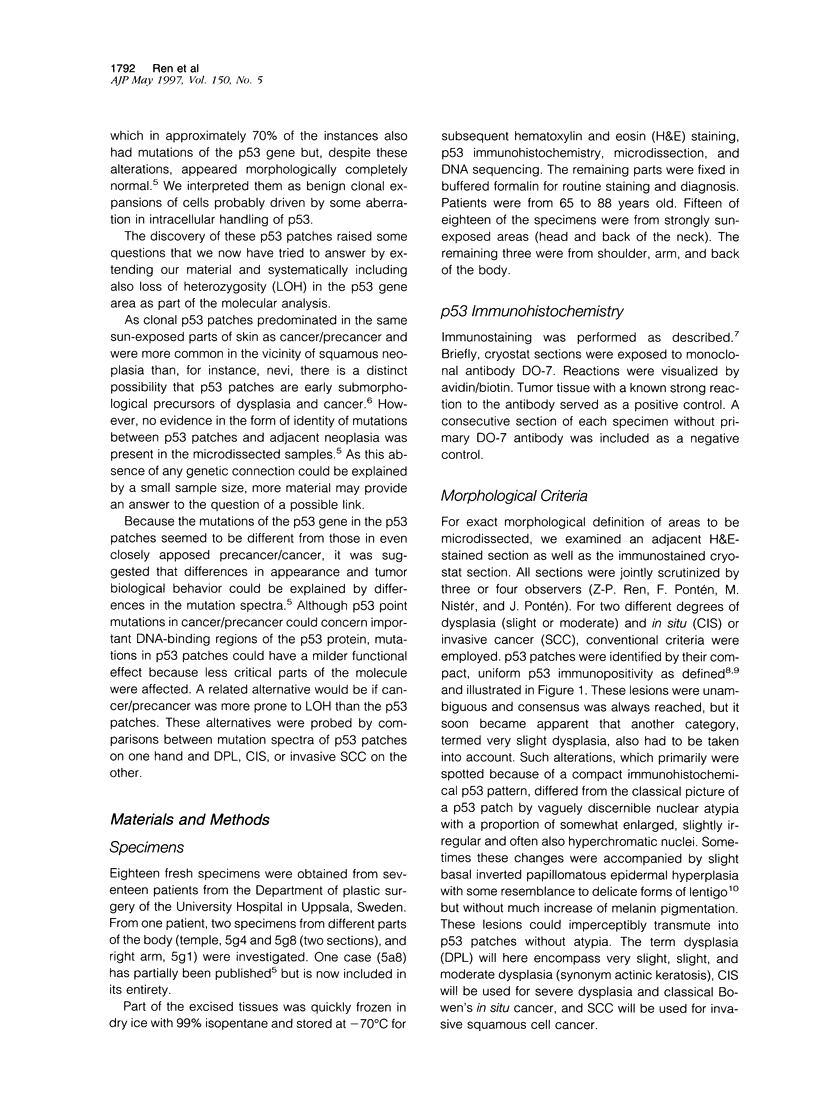
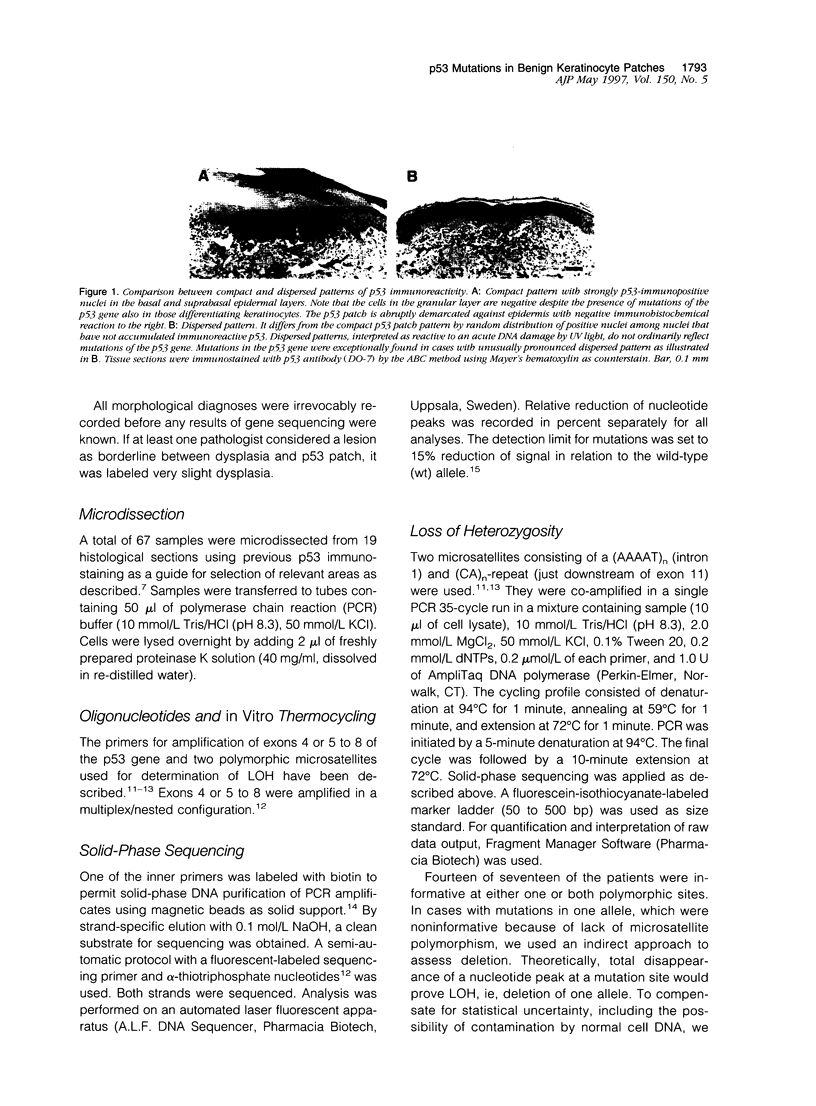
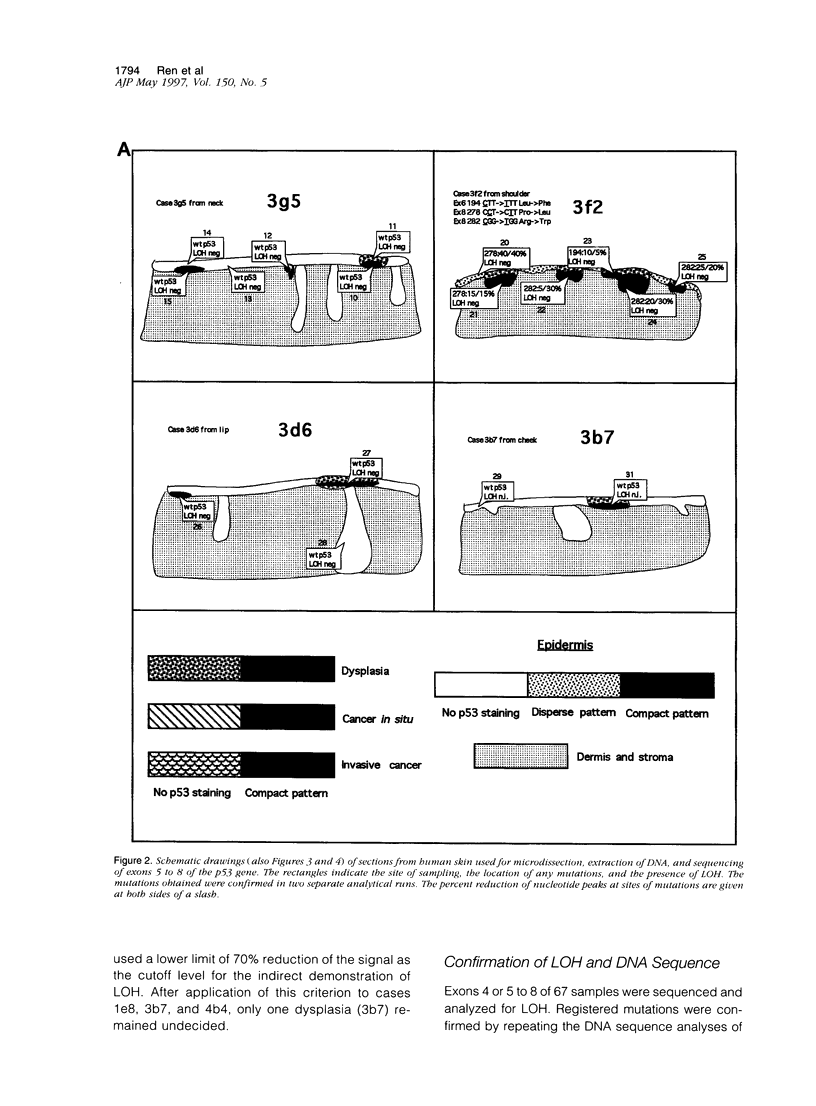
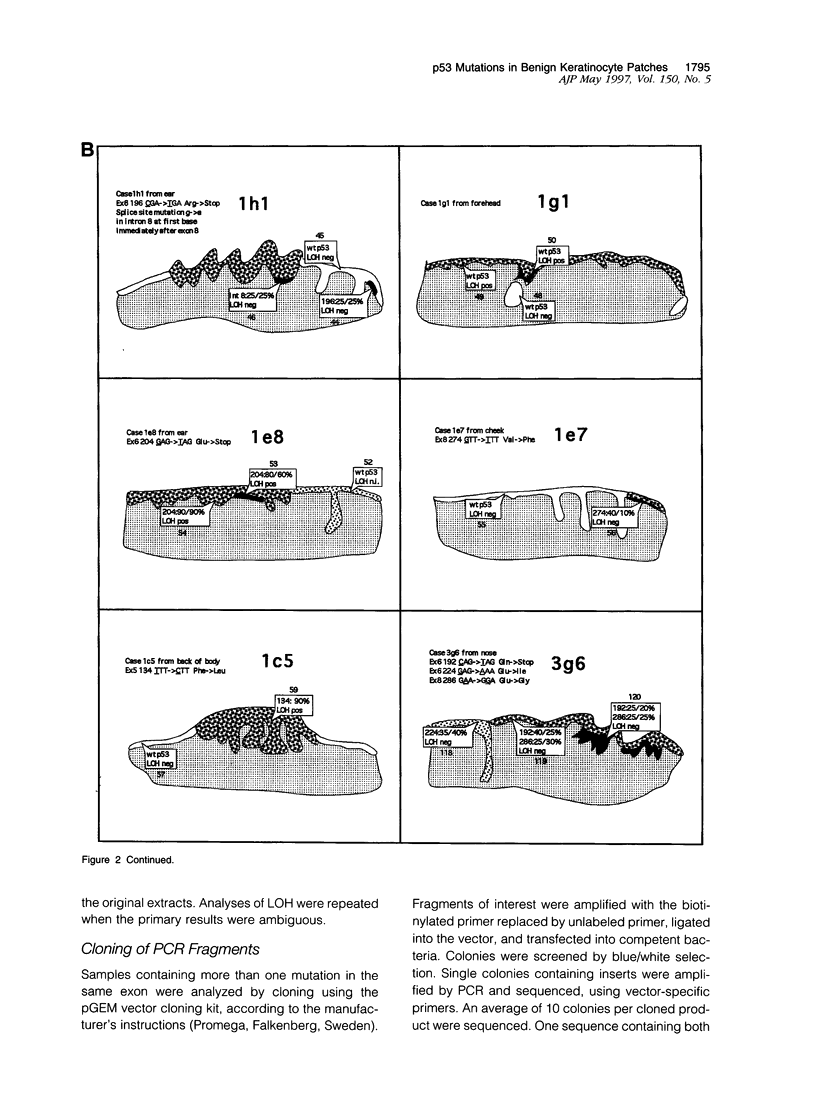
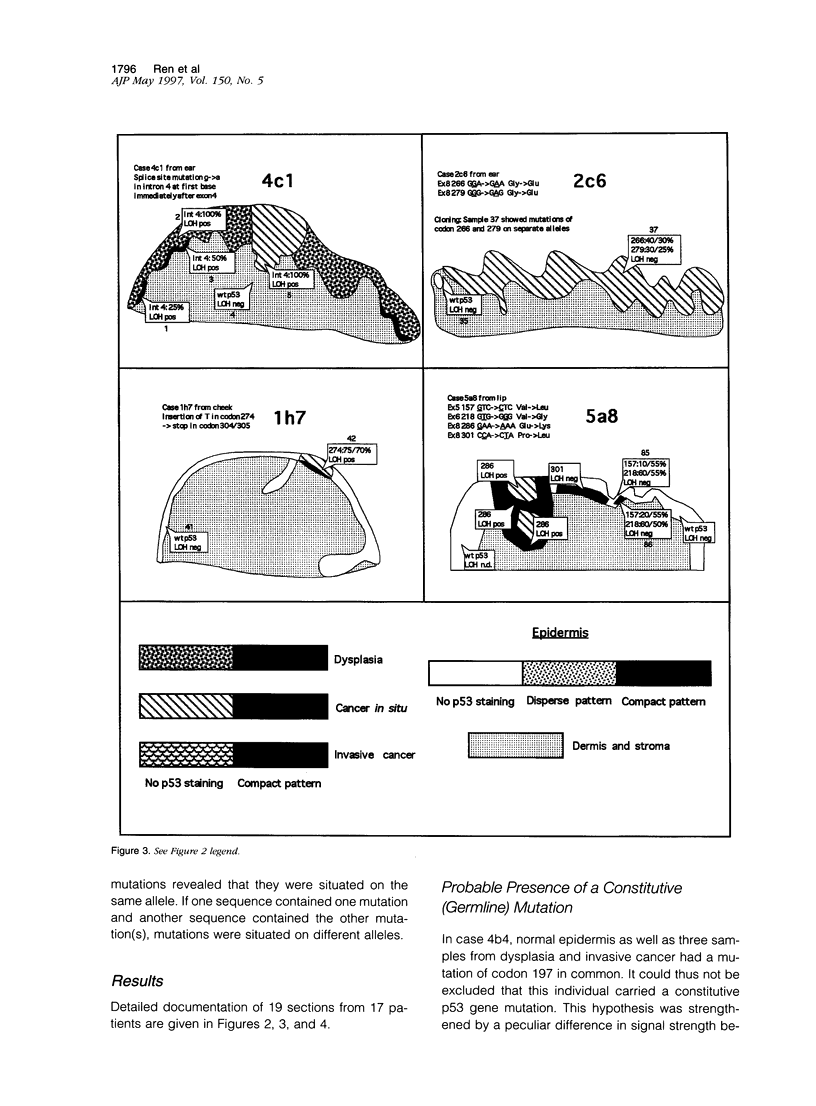
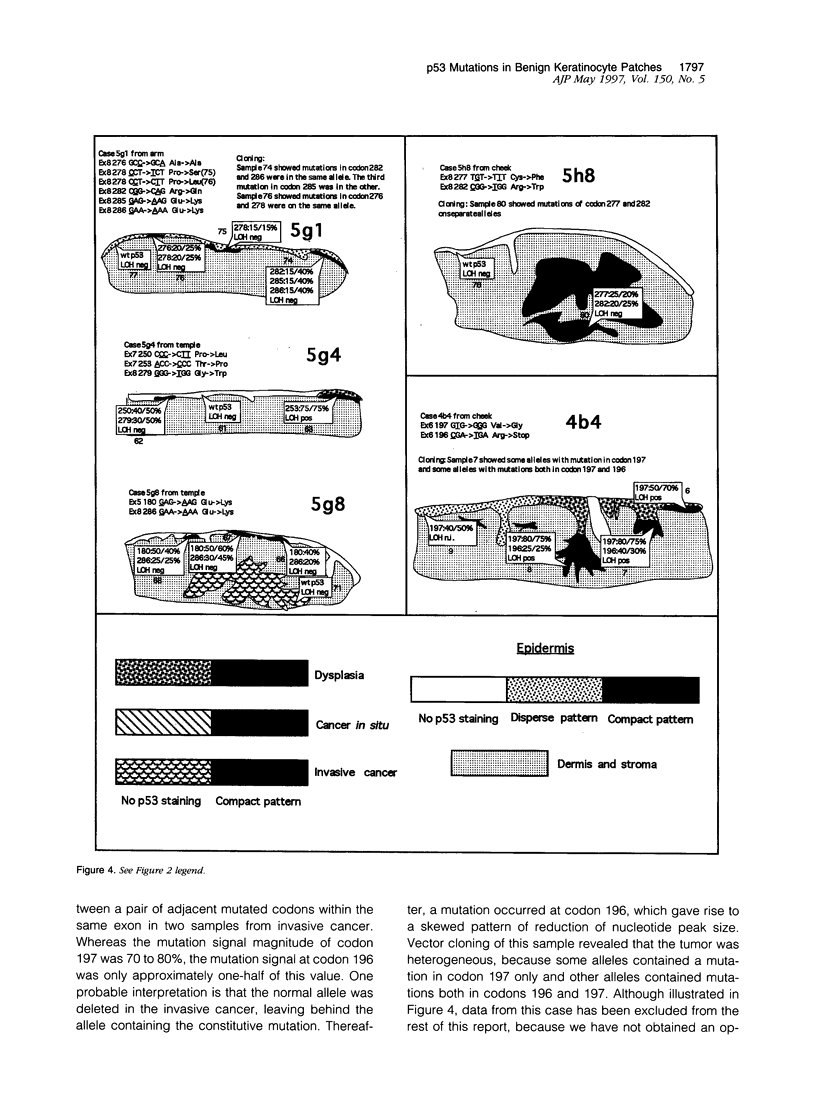
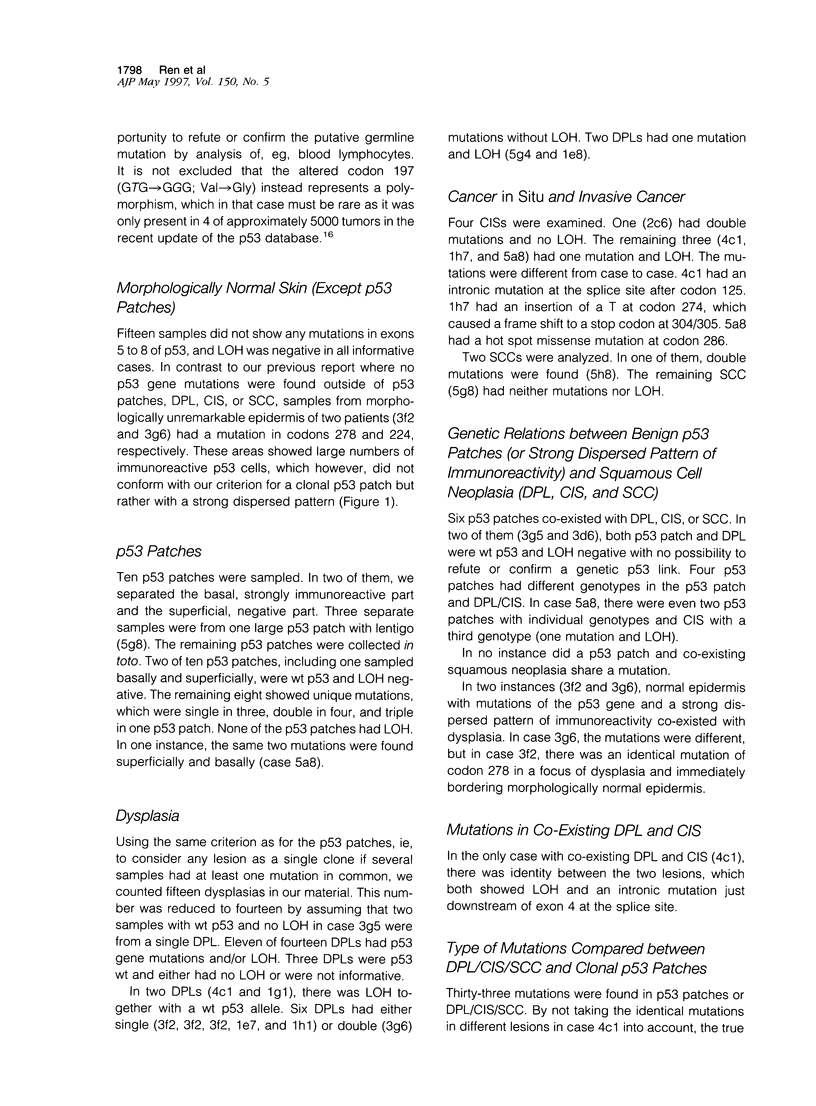
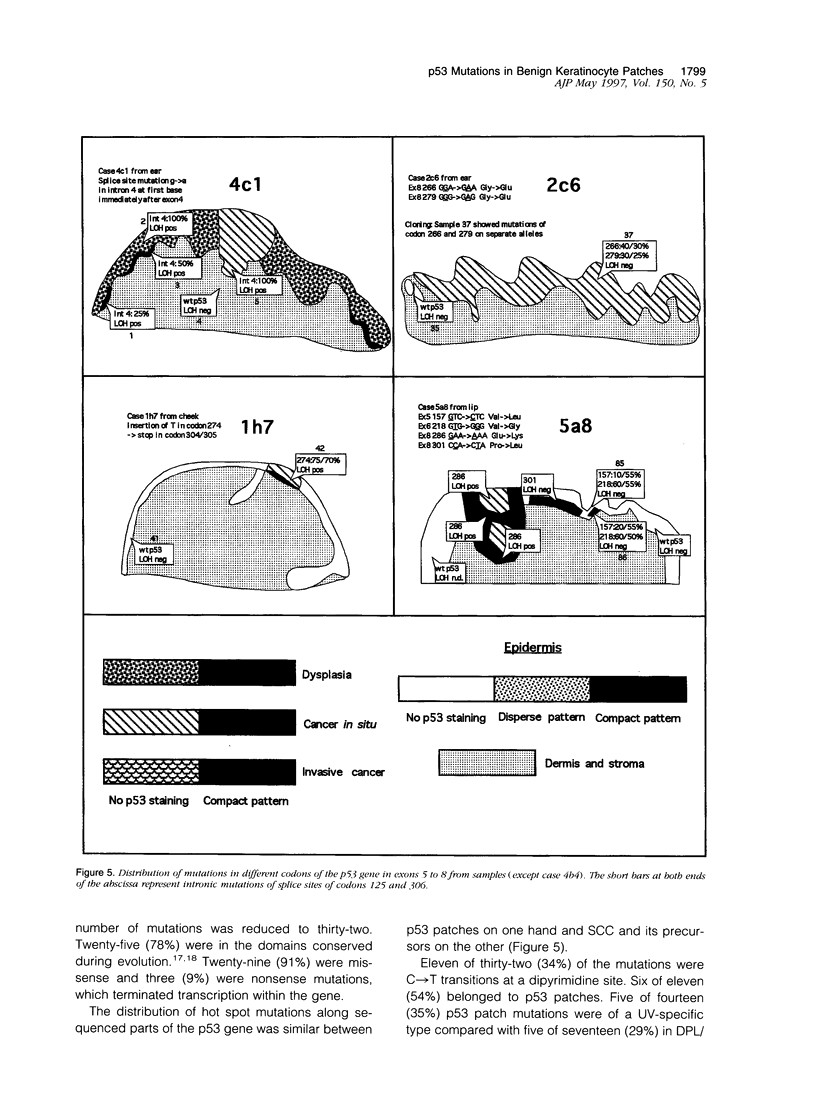
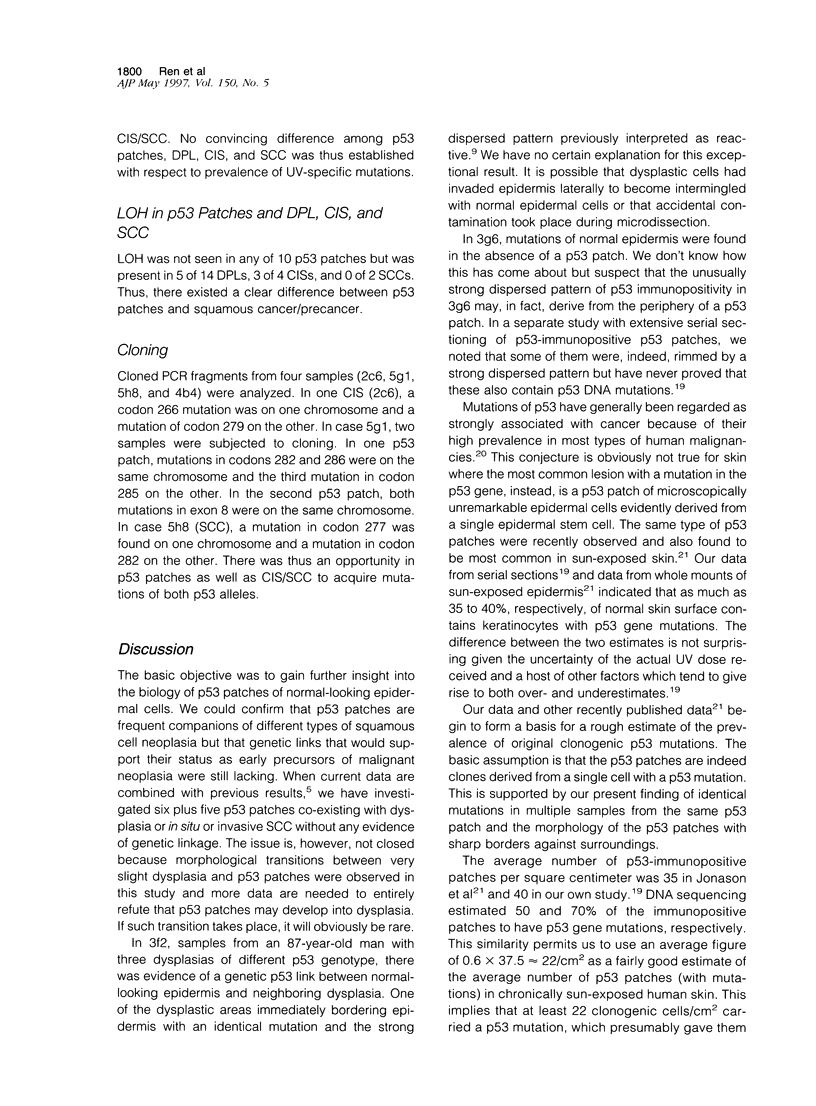
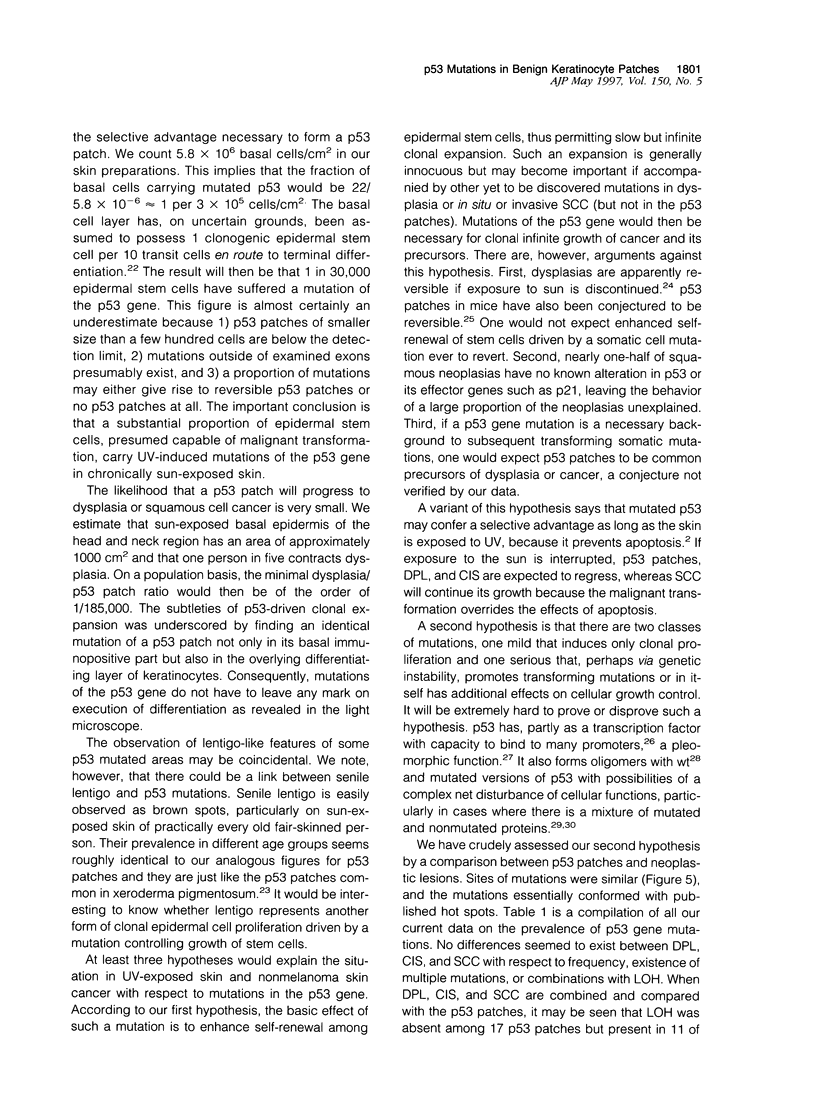
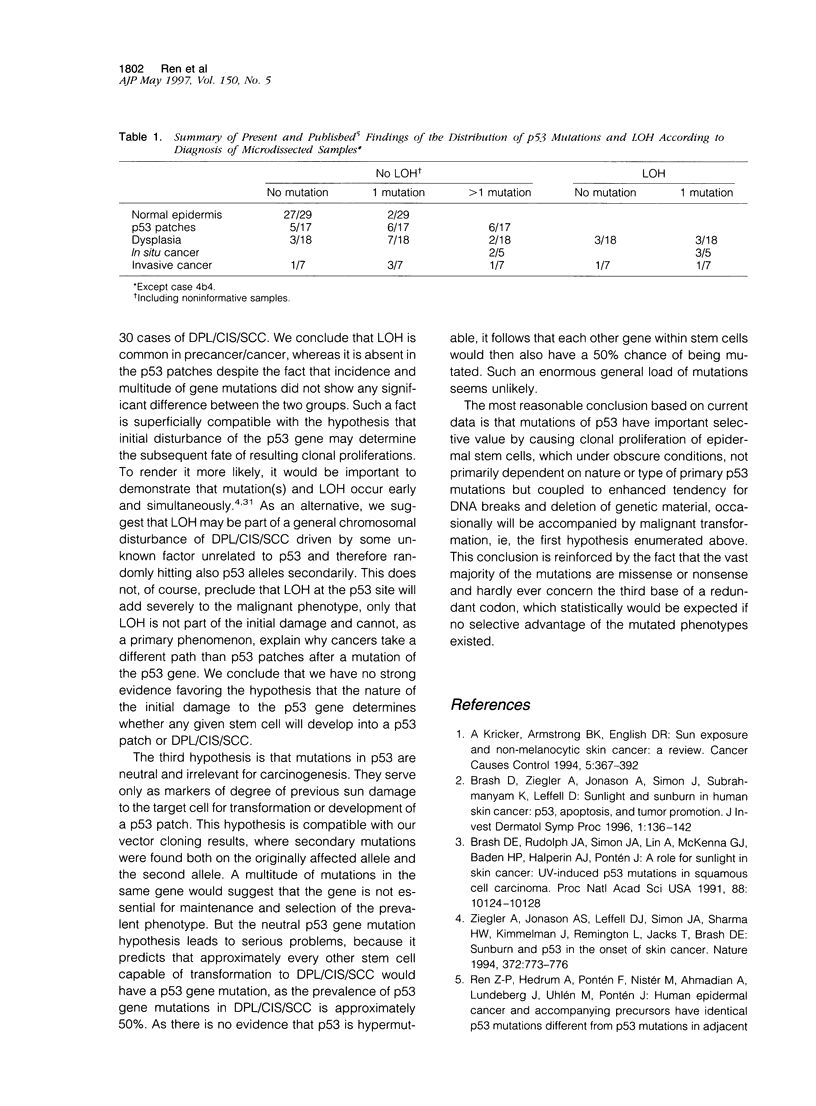
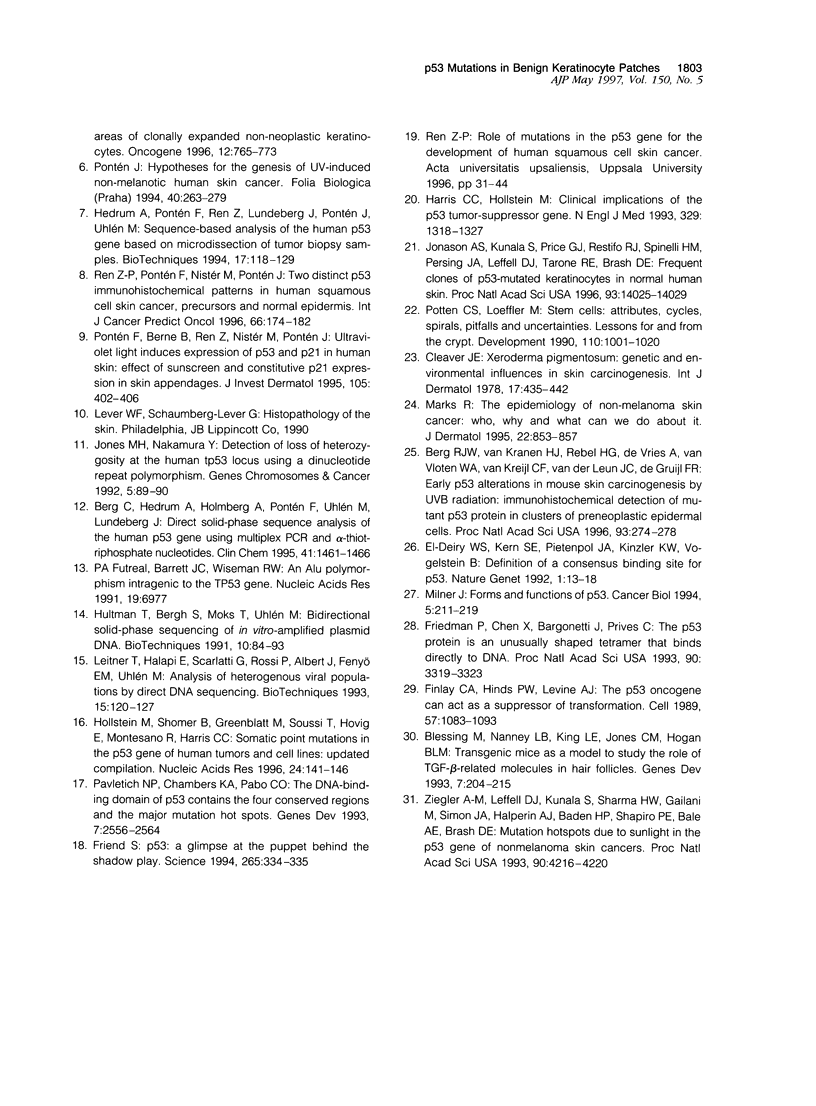
Images in this article
Selected References
These references are in PubMed. This may not be the complete list of references from this article.
- Berg C., Hedrum A., Holmberg A., Pontén F., Uhlén M., Lundeberg J. Direct solid-phase sequence analysis of the human p53 gene by use of multiplex polymerase chain reaction and alpha-thiotriphosphate nucleotides. Clin Chem. 1995 Oct;41(10):1461–1466. [PubMed] [Google Scholar]
- Berg R. J., van Kranen H. J., Rebel H. G., de Vries A., van Vloten W. A., Van Kreijl C. F., van der Leun J. C., de Gruijl F. R. Early p53 alterations in mouse skin carcinogenesis by UVB radiation: immunohistochemical detection of mutant p53 protein in clusters of preneoplastic epidermal cells. Proc Natl Acad Sci U S A. 1996 Jan 9;93(1):274–278. doi: 10.1073/pnas.93.1.274. [DOI] [PMC free article] [PubMed] [Google Scholar]
- Blessing M., Nanney L. B., King L. E., Jones C. M., Hogan B. L. Transgenic mice as a model to study the role of TGF-beta-related molecules in hair follicles. Genes Dev. 1993 Feb;7(2):204–215. doi: 10.1101/gad.7.2.204. [DOI] [PubMed] [Google Scholar]
- Brash D. E., Rudolph J. A., Simon J. A., Lin A., McKenna G. J., Baden H. P., Halperin A. J., Pontén J. A role for sunlight in skin cancer: UV-induced p53 mutations in squamous cell carcinoma. Proc Natl Acad Sci U S A. 1991 Nov 15;88(22):10124–10128. doi: 10.1073/pnas.88.22.10124. [DOI] [PMC free article] [PubMed] [Google Scholar]
- Brash D. E., Ziegler A., Jonason A. S., Simon J. A., Kunala S., Leffell D. J. Sunlight and sunburn in human skin cancer: p53, apoptosis, and tumor promotion. J Investig Dermatol Symp Proc. 1996 Apr;1(2):136–142. [PubMed] [Google Scholar]
- Cleaver J. E. Xeroderma pigmentosum: genetic and environmental influences in skin carcinogenesis. Int J Dermatol. 1978 Jul-Aug;17(6):435–444. doi: 10.1111/j.1365-4362.1978.tb06178.x. [DOI] [PubMed] [Google Scholar]
- Finlay C. A., Hinds P. W., Levine A. J. The p53 proto-oncogene can act as a suppressor of transformation. Cell. 1989 Jun 30;57(7):1083–1093. doi: 10.1016/0092-8674(89)90045-7. [DOI] [PubMed] [Google Scholar]
- Friedman P. N., Chen X., Bargonetti J., Prives C. The p53 protein is an unusually shaped tetramer that binds directly to DNA. Proc Natl Acad Sci U S A. 1993 Apr 15;90(8):3319–3323. doi: 10.1073/pnas.90.8.3319. [DOI] [PMC free article] [PubMed] [Google Scholar]
- Friend S. p53: a glimpse at the puppet behind the shadow play. Science. 1994 Jul 15;265(5170):334–335. doi: 10.1126/science.8023155. [DOI] [PubMed] [Google Scholar]
- Futreal P. A., Barrett J. C., Wiseman R. W. An Alu polymorphism intragenic to the TP53 gene. Nucleic Acids Res. 1991 Dec 25;19(24):6977–6977. doi: 10.1093/nar/19.24.6977. [DOI] [PMC free article] [PubMed] [Google Scholar]
- Harris C. C., Hollstein M. Clinical implications of the p53 tumor-suppressor gene. N Engl J Med. 1993 Oct 28;329(18):1318–1327. doi: 10.1056/NEJM199310283291807. [DOI] [PubMed] [Google Scholar]
- Hedrum A., Pontén F., Ren Z., Lundeberg J., Pontén J., Uhlén M. Sequence-based analysis of the human p53 gene based on microdissection of tumor biopsy samples. Biotechniques. 1994 Jul;17(1):118-9, 122-4, 126-9. [PubMed] [Google Scholar]
- Hollstein M., Shomer B., Greenblatt M., Soussi T., Hovig E., Montesano R., Harris C. C. Somatic point mutations in the p53 gene of human tumors and cell lines: updated compilation. Nucleic Acids Res. 1996 Jan 1;24(1):141–146. doi: 10.1093/nar/24.1.141. [DOI] [PMC free article] [PubMed] [Google Scholar]
- Hultman T., Bergh S., Moks T., Uhlén M. Bidirectional solid-phase sequencing of in vitro-amplified plasmid DNA. Biotechniques. 1991 Jan;10(1):84–93. [PubMed] [Google Scholar]
- Jonason A. S., Kunala S., Price G. J., Restifo R. J., Spinelli H. M., Persing J. A., Leffell D. J., Tarone R. E., Brash D. E. Frequent clones of p53-mutated keratinocytes in normal human skin. Proc Natl Acad Sci U S A. 1996 Nov 26;93(24):14025–14029. doi: 10.1073/pnas.93.24.14025. [DOI] [PMC free article] [PubMed] [Google Scholar]
- Jones M. H., Nakamura Y. Detection of loss of heterozygosity at the human TP53 locus using a dinucleotide repeat polymorphism. Genes Chromosomes Cancer. 1992 Jul;5(1):89–90. doi: 10.1002/gcc.2870050113. [DOI] [PubMed] [Google Scholar]
- Kricker A., Armstrong B. K., English D. R. Sun exposure and non-melanocytic skin cancer. Cancer Causes Control. 1994 Jul;5(4):367–392. doi: 10.1007/BF01804988. [DOI] [PubMed] [Google Scholar]
- Leitner T., Halapi E., Scarlatti G., Rossi P., Albert J., Fenyö E. M., Uhlén M. Analysis of heterogeneous viral populations by direct DNA sequencing. Biotechniques. 1993 Jul;15(1):120–127. [PubMed] [Google Scholar]
- Marks R. The epidemiology of non-melanoma skin cancer: who, why and what can we do about it. J Dermatol. 1995 Nov;22(11):853–857. doi: 10.1111/j.1346-8138.1995.tb03935.x. [DOI] [PubMed] [Google Scholar]
- Milner J. Forms and functions of p53. Semin Cancer Biol. 1994 Jun;5(3):211–219. [PubMed] [Google Scholar]
- Pavletich N. P., Chambers K. A., Pabo C. O. The DNA-binding domain of p53 contains the four conserved regions and the major mutation hot spots. Genes Dev. 1993 Dec;7(12B):2556–2564. doi: 10.1101/gad.7.12b.2556. [DOI] [PubMed] [Google Scholar]
- Pontén F., Berne B., Ren Z. P., Nistér M., Pontén J. Ultraviolet light induces expression of p53 and p21 in human skin: effect of sunscreen and constitutive p21 expression in skin appendages. J Invest Dermatol. 1995 Sep;105(3):402–406. doi: 10.1111/1523-1747.ep12321071. [DOI] [PubMed] [Google Scholar]
- Pontén J. Hypotheses for the genesis of UV-induced non-melanotic human skin cancer. Folia Biol (Praha) 1994;40(5):263–279. [PubMed] [Google Scholar]
- Potten C. S., Loeffler M. Stem cells: attributes, cycles, spirals, pitfalls and uncertainties. Lessons for and from the crypt. Development. 1990 Dec;110(4):1001–1020. doi: 10.1242/dev.110.4.1001. [DOI] [PubMed] [Google Scholar]
- Ren Z. P., Pontén F., Nistér M., Pontén J. Two distinct p53 immunohistochemical patterns in human squamous-cell skin cancer, precursors and normal epidermis. Int J Cancer. 1996 Jun 21;69(3):174–179. doi: 10.1002/(SICI)1097-0215(19960621)69:3<174::AID-IJC4>3.0.CO;2-X. [DOI] [PubMed] [Google Scholar]
- Ziegler A., Jonason A. S., Leffell D. J., Simon J. A., Sharma H. W., Kimmelman J., Remington L., Jacks T., Brash D. E. Sunburn and p53 in the onset of skin cancer. Nature. 1994 Dec 22;372(6508):773–776. doi: 10.1038/372773a0. [DOI] [PubMed] [Google Scholar]
- Ziegler A., Leffell D. J., Kunala S., Sharma H. W., Gailani M., Simon J. A., Halperin A. J., Baden H. P., Shapiro P. E., Bale A. E. Mutation hotspots due to sunlight in the p53 gene of nonmelanoma skin cancers. Proc Natl Acad Sci U S A. 1993 May 1;90(9):4216–4220. doi: 10.1073/pnas.90.9.4216. [DOI] [PMC free article] [PubMed] [Google Scholar]



